The article deals with the study of initial and final speech formulas in Lezgian and Ukrainian fairy tales. The structure and semantic features of these speech constructions in the fairy tale narrative are analyzed. Special attention is paid to the description of their axiological content. The analysis results show that the initial and final formulas in Lezgian and Ukrainian fairy tales have a similar structure consisting of several semantic blocks, with each block having a specific linguistic content provided by the national tradition. It shows that the analyzed speech formulas are prone to variability, which is usually provided by the synonymy of the elements contained in them, as well as the ways of their compatibility. Initial and final formulas in fairy tales can be subject to the amplification, i.e. complications, such as wide use of synonymous constructions of the same type, and reduction (reduction of the share of information). At the end of the study, the author concludes that the initial and final speech formulas of fairy tales are universal. At the same time, there is a distinct national specificity in their structure, semantics and functional features, allowing us to consider them as an effective mechanism for marking and preservation of ethnocultural meanings.
fairy tales, axiological model, traditional speech formulas, initial formulas, final formulas, Lezgian linguoculture, Ukrainian linguoculture.
1. Gasanova D. S. Lingvokul'turologicheskie i strukturno-semanticheskie osobennosti yazyka skazki: na materiale lezginskogo, russkogo i angliyskogo yazykov: Avtoref. diss. kand. filol. nauk: 10.02.20.
2. Gerasimova N. M. Prostranstvenno-vremennye formuly russkoy volshebnoy skazki // Pragmatika teksta. Fol'klor. Literatura. Kul'tura. – SPb., 2012. – S. 173–180.
3. Gerasimova N. M. Formuly russkoy volshebnoy skazki (k probleme stereotipnosti i variativnosti tradicionnoy kul'tury) // Pragmatika teksta. Fol'klor. Literatura. Kul'tura. –SPb., 2012.
4. Z zhivogo dzherela: Ukraїns'kі narodnі kazki v zapisah, perekazah ta publіkacіyah ukraїns'kih pis'mennikіv / Uporyad., lіter, obrobka, vstup, st. ta primіt. L. Dunaєvs'koї. – K.: Radyans'ka shkola, 1990.
5. Lezgi Halk'din mahar / sost. G. G. Gasharov, A. M. Ganieva. – Mahachkala, 1989. – 160 s.
6. Mal'ceva T. I. Raznoobrazie formul volshebnoy skazki kak rezul'tat ih var'irovaniya // Mir nauki, kul'tury, obrazovaniya. – 2020. – № 5 (84). – S. 302–303.
7. Obschaya i russkaya lingvoaksiologiya: Kollektivnaya monografiya / otv. red. M. S. Milovanova. – M. – Yaroslavl': Izdatel'stvo «Kancler», 2022. – 390 s.
8. Ostrovskaya K. Z. Inicial'nye i final'nye formuly kak sredstvo reprezentacii fantasticheskogo hronotopa: na materiale russkih, nemeckih i angliyskih narodnyh volshebnyh skazok
9. Petrova E. E. Strukturno-semanticheskie i pragmaticheskie osobennosti formul'nyh kompozicionnyh sredstv (na materiale britanskih i russkih narodnyh skazok)
10. Propp V. Ya. Morfologiya volshebnoy skazki. – M.: Labirint, 2001. – 192 s.
11. Roshiyanu N. Tradicionnye formuly skazki. – M.: Nauka, 1974. – 216 s.
12. Serebrennikova E. F. Aspekty aksiologicheskogo lingvisticheskogo analiza // Lingvistika i aksiologiya: etnosemiometriya cennostnyh smyslov: kollektivnaya monografiya. – M.: Tezaurus, 2011.
13. Uzhchenko V. D., Uzhchenko D. V. Frazeologіchniy slovnik ukraїns'koї movi. – K.: Osvіta, 1998. – 224 s.
14. Chistov K. V. Fol'klor. Tekst. Tradiciya: sb. st. – M.: OGI, 2005. – 272 s.





